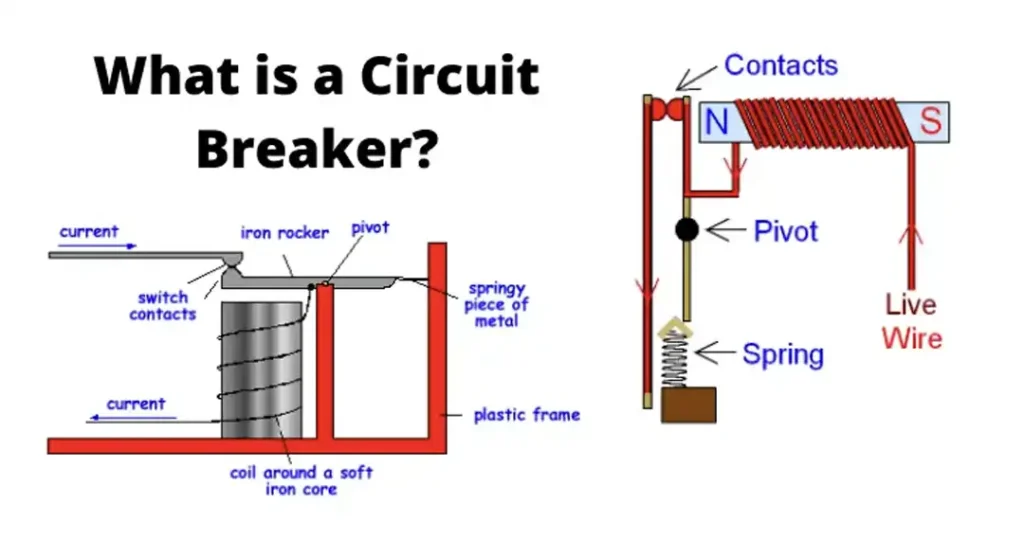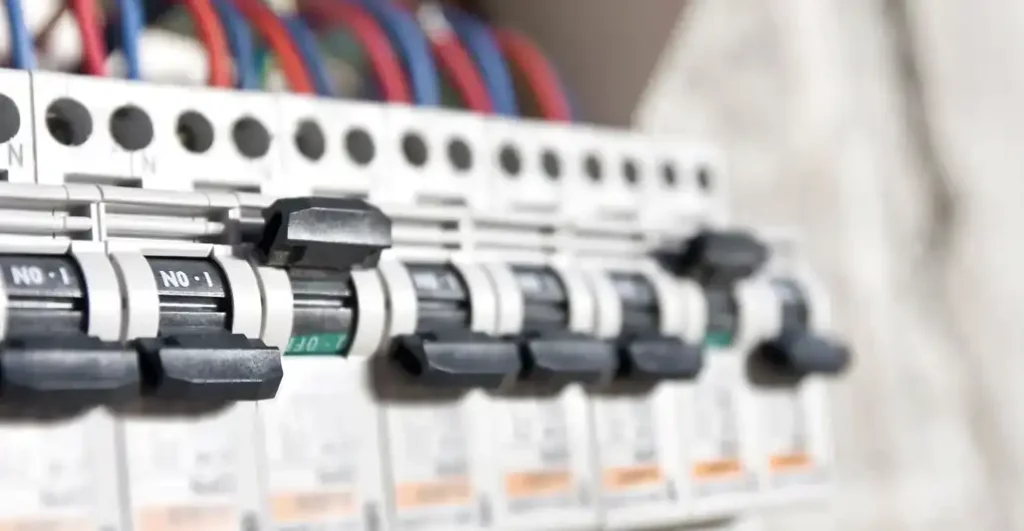Circuit breakers are the unsung heroes of our electrical systems, silently protecting our homes and businesses from electrical mishaps.
But how long does a circuit breaker last? Understanding their lifespan is crucial to maintaining a safe and functional electrical system.
What is a Circuit Breaker?

A circuit breaker is a safety device designed to interrupt the flow of electricity in a circuit when an overload or short circuit occurs. Its primary function is to prevent electrical fires and damage to appliances by shutting off the power supply when it detects a fault.
Types of Circuit Breakers
Circuit breakers come in various types, each suited for different applications:
Miniature Circuit Breakers (MCB)
MCBs are small and commonly used in residential and light commercial settings. They protect against overloads and short circuits in low-voltage circuits.
Molded Case Circuit Breakers (MCCB)
MCCBs are larger and can handle higher currents than MCBs. They are typically used in industrial and commercial environments.
Ground Fault Circuit Interrupters (GFCI)
GFCIs are designed to protect against ground faults, where the electric current escapes to the ground. They are commonly found in areas with high moisture levels, such as bathrooms and kitchens.
Arc Fault Circuit Interrupters (AFCI)
AFCIs detect and prevent arc faults, which can cause electrical fires. They are increasingly used in residential wiring to enhance safety.
How Long Does a Circuit Breaker Last

Circuit breakers are essential components of electrical systems, designed to protect against overcurrent and short circuits that could lead to electrical fires or damage to equipment. The lifespan of a circuit breaker depends on various factors including its quality, usage, environment, and maintenance.
Generally, well-maintained circuit breakers can last for decades. High-quality breakers may have lifespans of 30 years or more, while lower-quality or poorly maintained ones may fail sooner.
Here are some factors that influence the lifespan of a circuit breaker:
- Quality: High-quality circuit breakers, made by reputable manufacturers, tend to have longer lifespans than cheaper, less reliable ones.
- Usage: Circuit breakers in heavily used electrical systems may wear out more quickly than those in lightly used systems. Frequent tripping or high current loads can contribute to wear and tear.
- Environment: The environment in which the circuit breaker operates can affect its lifespan. Exposure to moisture, extreme temperatures, dust, or corrosive chemicals can degrade components over time.
- Maintenance: Regular maintenance, including inspection, testing, and cleaning, can extend the lifespan of a circuit breaker. Loose connections, worn-out components, or signs of damage should be addressed promptly.
- Type: Different types of circuit breakers, such as electromechanical or solid-state, may have varying lifespans. Solid-state breakers, for example, typically have no moving parts and may be more durable than traditional electromechanical ones.
- Age: As circuit breakers age, their components may deteriorate or become less reliable. Regular inspection and testing can help identify signs of aging and potential failure.
- Load: The amount of current flowing through the circuit breaker can affect its lifespan. Constant high loads or frequent overcurrent conditions may shorten the breaker’s lifespan.
While there is no fixed lifespan for a circuit breaker, proper installation, regular maintenance, and attention to usage conditions can help maximize its longevity and ensure reliable protection for electrical systems.
Factors Affecting Circuit Breaker Lifespan

The lifespan of a circuit breaker, including its life expectancy and service life, depends on various factors that affect its durability and reliability. These factors determine how long a circuit breaker can effectively function before requiring replacement or maintenance.
Circuit breaker lifespan is influenced by several key factors, such as quality, usage patterns, environmental conditions, maintenance practices, and technological advancements.
Quality plays a crucial role in determining the longevity of a circuit breaker. High-quality circuit breakers, often manufactured by reputable companies, are typically built with durable materials and undergo rigorous testing to ensure reliability. These breakers tend to have longer service lives compared to lower-quality alternatives.
Usage patterns also impact circuit breaker life. Breakers subjected to frequent operations, such as those protecting heavily loaded circuits or experiencing frequent faults, may wear out faster than those in less demanding applications. Environmental conditions, such as temperature extremes, humidity, dust, and corrosive atmospheres, can accelerate wear and deterioration of circuit breaker components, thus shortening their lifespan.
Regular maintenance practices are essential for extending the service life of circuit breakers. Routine inspections, testing, and cleaning help identify and address potential issues before they escalate into failures. Proper maintenance can also prevent premature wear and ensure that circuit breakers operate within their specified parameters.
Technological advancements have led to improvements in circuit breaker design and materials, potentially extending their lifespan. Modern molded case circuit breakers, for example, may offer enhanced features and reliability compared to older models. However, even with advancements in technology, it’s essential to consider factors such as environmental conditions and maintenance practices to maximize the lifespan of circuit breakers.
While there is no fixed lifespan for circuit breakers, a well-maintained and properly installed breaker can last for several decades. However, as circuit breakers age, their components may deteriorate, increasing the risk of failure. Regular evaluation of circuit breakers and replacement when necessary are essential to ensure the continued safety and reliability of electrical systems.
Several factors influence how long a circuit breaker can effectively function:
Quality of the Circuit Breaker
High-quality circuit breakers, often from reputable manufacturers, tend to last longer due to superior materials and construction.
Frequency of Use
Circuit breakers that are frequently tripped may wear out faster than those that rarely trip.
Electrical Load
Consistently high electrical loads can stress a circuit breaker, reducing its lifespan.
Environmental Conditions
Exposure to extreme temperatures, humidity, or corrosive environments can deteriorate a circuit breaker more quickly.
Typical Lifespan of Circuit Breakers
Manufacturer’s Specifications
Most manufacturers provide an estimated lifespan for their circuit breakers, typically ranging from 15 to 20 years.
Industry Standards
Industry standards suggest that circuit breakers should be inspected regularly and replaced every 20-30 years, depending on usage and conditions.
Average Lifespan of Different Types
- MCBs: 15-20 years
- MCCBs: 20-30 years
- GFCIs: 10-15 years
- AFCIs: 15-20 years
Signs Your Circuit Breaker Needs Replacement
Several signs indicate that a circuit breaker may need replacement to ensure the continued safety and reliability of your electrical system. Here are some common indicators to watch for:
Frequent Tripping: If a circuit breaker trips frequently without apparent cause, it could indicate that the breaker is worn out or damaged. While occasional tripping is normal under heavy loads or during electrical surges, frequent tripping may warrant further inspection.
Tripping Without Load: If a circuit breaker trips when there is no significant load on the circuit, it may indicate internal damage or wear. This can be a sign that the breaker is no longer able to handle its rated capacity reliably.
Physical Damage: Visible signs of physical damage, such as cracks, chips, or discoloration on the circuit breaker itself, indicate potential issues. Damaged circuit breakers may not provide adequate protection and should be replaced promptly.
Overheating: Excessive heat around the circuit breaker or a burning smell when the breaker is in use suggests overheating. This can occur due to loose connections, overloaded circuits, or internal faults within the breaker. Overheating poses a fire risk and requires immediate attention.
Tripping Won’t Reset: If a circuit breaker trips and refuses to reset or remains in the tripped position, it could indicate a serious fault within the breaker. Attempting to force the breaker to reset can be dangerous and should be avoided.
Age: Consider the age of the circuit breaker. While well-maintained breakers can last for many years, older breakers may become less reliable over time due to wear and tear on internal components. As a general guideline, circuit breakers older than 20-30 years may be candidates for replacement.
Audible Humming or Buzzing: Unusual sounds coming from the circuit breaker panel, such as humming or buzzing noises, can indicate internal arcing or loose connections. These issues require immediate attention to prevent electrical hazards.
Tripped Breaker Won’t Stay Reset: If a circuit breaker trips repeatedly after being reset, even with a reduced load or after addressing potential causes of overload, it may indicate a failing breaker that needs replacement.
Diminished Performance: Any noticeable decrease in the performance or reliability of electrical circuits protected by the breaker could be a sign of underlying issues with the breaker itself. Investigate and address these concerns promptly.
If you observe any of these signs or suspect that your circuit breaker may be compromised, it’s important to consult a qualified electrician for further evaluation and, if necessary, replacement. Ignoring potential issues with circuit breakers can pose serious safety risks and may lead to electrical hazards.
How to Prolong the Lifespan of Circuit Breakers
To extend the lifespan of circuit breakers and maintain electrical safety, consider the following practices:
- Regular Inspection: Schedule routine inspections to check for signs of wear, damage, or overheating. Look for loose connections, corrosion, or any physical damage to the breaker or surrounding components.
- Testing: Conduct periodic testing to ensure the proper functioning of the circuit breaker. Use appropriate testing equipment to verify that the breaker trips at the correct current levels and reacts promptly to faults.
- Cleanliness: Keep the circuit breaker and its surroundings clean and free of dust, dirt, and debris. Use compressed air or gentle brushes to remove any buildup that could impair performance or cause overheating.
- Avoid Overloading: Be mindful of the electrical load on circuits protected by circuit breakers. Avoid overloading circuits beyond their rated capacity, as this can lead to overheating and premature failure of the breaker.
- Temperature Control: Ensure that circuit breakers are installed in environments with controlled temperatures. Avoid exposure to extreme heat or cold, as temperature fluctuations can affect the performance and lifespan of the breaker.
- Proper Installation: Ensure that circuit breakers are installed correctly according to manufacturer guidelines and electrical codes. Improper installation can lead to issues such as poor connections or inadequate protection, impacting the lifespan of the breaker.
- Use Surge Protection: Install surge protection devices to safeguard circuit breakers and electrical equipment from voltage spikes caused by lightning or power surges. This can help prevent damage and extend the lifespan of the breaker.
- Timely Maintenance: Address any issues promptly to prevent further damage or deterioration. Repair or replace components as needed, and consider scheduling preventive maintenance to identify potential problems before they escalate.
- Training and Education: Ensure that personnel responsible for handling electrical systems are properly trained and educated on best practices for circuit breaker maintenance and safety.
By following these guidelines and maintaining regular upkeep, you can prolong the lifespan of circuit breakers, ensuring reliable operation and minimizing the risk of electrical hazards.
How Long Are Circuit Breaker Halts
The duration of a circuit breaker halt, also known as a trip or interruption, can vary depending on the cause and the type of circuit breaker. When a circuit breaker detects an overcurrent or short circuit, it trips to interrupt the flow of electricity and prevent damage to the electrical system or equipment.
In most cases, circuit breakers are designed to trip almost instantaneously when they detect a fault, typically within milliseconds to a few cycles of the electrical frequency (usually 50 or 60 Hz). This rapid response helps minimize potential damage and hazards.
Once a circuit breaker trips, it remains in the tripped state until manually reset or until the fault condition is resolved. Manual reset circuit breakers require the user to physically reset the breaker after troubleshooting and addressing the underlying issue. Automatic reset circuit breakers may attempt to reset themselves after a brief delay once the fault condition clears, although this feature is more commonly found in low-voltage and automotive applications.
The duration of a circuit breaker halt can be influenced by factors such as the magnitude of the fault current, the speed of the breaker’s trip mechanism, and any delay settings programmed into the breaker. Additionally, some circuit breakers may incorporate built-in time-delay features to accommodate temporary overloads without tripping unnecessarily.
Circuit breaker halts are typically brief and occur rapidly upon detection of a fault to protect the electrical system and equipment from damage.
Conclusion
In conclusion, the lifespan of a circuit breaker can vary depending on factors such as quality, usage, environment, maintenance, type, age, load characteristics, and more.
While well-maintained circuit breakers from reputable manufacturers can last for several decades, lower-quality or poorly maintained ones may fail sooner. Regular inspections, testing, and maintenance, along with proper installation and load management, can help prolong the lifespan of circuit breakers and ensure the continued safety and reliability of electrical systems.
However, it’s essential to monitor for signs of wear, damage, or malfunction and replace circuit breakers as needed to prevent electrical hazards and maintain optimal performance.
FAQs
How can I tell if my circuit breaker is bad?
Look for signs like frequent tripping, physical damage, or burn marks. A professional inspection can provide a definitive answer.
Can I replace a circuit breaker myself?
While it’s possible, it’s safer to hire a qualified electrician to ensure the replacement is done correctly.
How often should circuit breakers be inspected?
Circuit breakers should be inspected at least once a year by a professional.
What are the consequences of not replacing a faulty circuit breaker?
A faulty breaker can lead to electrical fires, damaged appliances, and other serious safety hazards.




















